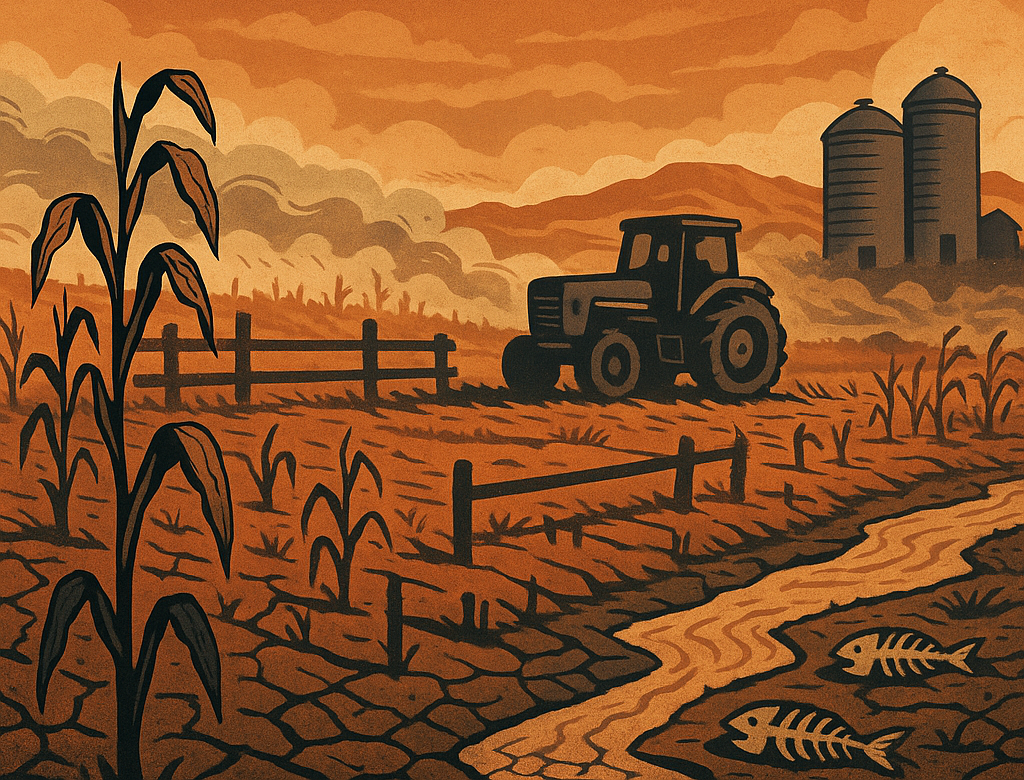Why Agriculture as We Know It Has Already Failed

The global agricultural system teeters on the edge of collapse, caught between the crushing weight of industrial excess and the urgent demands of a warming planet. In the wealthy nations that pioneered industrial farming, the bill has come due with devastating clarity. One-third of the world’s farmland lies severely degraded, with Iowa having lost half its topsoil in just 150 years and Europe hemorrhaging 970 million tons of soil annually. The Ogallala Aquifer, lifeblood of America’s breadbasket, drops inexorably by 1.5 feet each year while India’s Punjab, once the Green Revolution’s greatest triumph, races toward complete aquifer depletion by 2039. California’s Central Valley literally sinks into the earth as desperate farmers pump groundwater from ever-deeper wells.
Climate chaos has moved from future threat to present reality. The U.S. Midwest lurches between unprecedented floods and punishing droughts, European heatwaves incinerate crops with increasing regularity, and Australia watches its wheat belt migrate southward in real time. The industrial agriculture complex responds with more of the same failed medicine: precision farming, gene editing, and artificial intelligence that promise efficiency while ignoring the fundamental unsustainability of the system itself. These expensive technological band-aids will reach wealthy farmers first, leaving the global poor to face the consequences alone.
Africa embodies agriculture’s most tragic paradox. Despite holding 60% of the world’s uncultivated arable land, the continent imports $75 billion in food annually while foreign powers orchestrate a modern colonial land grab. China operates 240 agricultural projects across African soil, Gulf states lease millions of hectares for export crops, and local farmers find themselves displaced from their ancestral lands while their own countries import the food they need to survive. The climate crisis hits Africa with particular brutality: the Sahel advances 1.5 miles southward each year, East Africa’s once-predictable rains have become chaotic, and fall armyworm—unknown on the continent before 2016—now ravages crops in 44 countries. Temperature rises of just 2°C will render vast areas unsuitable for current crops.
The human dimension of this crisis plays out in the exodus of African youth from farming. With the average farmer age at 60, young people flee agriculture en masse, seeing only backbreaking poverty in fields that lack mechanization, market access, or decent incomes. Yet these same youth face 15-30% unemployment rates in cities that cannot absorb them. Infrastructure gaps compound every problem: post-harvest losses reach 40% for perishables due to poor roads and absent cold storage, forcing farmers to sell cheap at harvest and buy expensive months later. These are problems that should have been solved decades ago, yet they persist into 2025 with deadly consequences.
Corporate concentration strangles agricultural diversity worldwide. Six companies control 77% of global seed sales, four firms dominate 90% of grain trading, and this monopolistic structure grants them unprecedented power over the world’s food supply. Hybrid seeds force annual purchases, pesticides create chemical dependencies, and fertilizer cartels coordinate prices to maximize profit. Small farmers everywhere face the same relentless squeeze. The new frontier of control lies in data: John Deere’s tractors surveil fields, Bayer’s apps monitor crop health, and this information gets monetized while farmers pay for the privilege of their own surveillance. Trade rules entrench these imbalances, with U.S. farm subsidies totaling $20 billion annually and the EU’s Common Agricultural Policy dispensing €387 billion over seven years—subsidies that African farmers must compete against in supposedly “free” markets.
Water has become agriculture’s most critical constraint, with irrigation consuming 70% of global freshwater withdrawals as supplies dwindle and conflicts intensify. Ethiopia’s Renaissance Dam threatens Egypt’s Nile water lifeline, India and Pakistan edge toward conflict over the Indus, and the Colorado River no longer reaches the sea after being drained by competing demands. Nations engage in groundwater mining on an industrial scale: Saudi Arabia exhausted its fossil aquifers growing wheat, then pivoted to leasing land in Arizona to drain American aquifers instead. This pattern repeats globally as wealthy nations export their water crises to poorer regions. When cities face water shortages—as Cape Town nearly did in 2018 and Chennai experienced in 2019—urban voters invariably win allocation battles against rural farmers.
Food has always been power, but governments now wield it with increasing ruthlessness. Export bans proliferate whenever supplies tighten. Nationalism trumps trade agreements when hunger threatens. Political calculus keeps destructive subsidies in place because no politician risks rural votes by cutting farm support, so unsustainable practices receive rewards while regenerative farmers struggle without recognition. The climate refugee crisis adds another dimension of instability—Syria’s drought preceded its civil war, Central American crop failures drive migration northward, and as farming collapses, human movement creates cascading political crises.
Real solutions exist but require confronting entrenched power structures head-on. Land reform cannot wait any longer: small farmers need secure tenure rights, foreign land grabs must end, and idle estates require redistribution. Without ownership security, nothing else matters. Input monopolies must be broken through open-source seeds, farmer-controlled cooperatives, and regional fertilizer production—the technology exists but political will remains absent. Subsidies need radical redirection from rewarding monocultures and chemical inputs to paying farmers for carbon sequestration, biodiversity, and water conservation. Making sustainability profitable isn’t idealism; it’s survival.
The unsexy infrastructure investments matter most: rural roads, local processing facilities, cold storage chains, and farmer education centers. These basics eclipse apps and drones in importance. Climate adaptation cannot be delayed: heat-resistant crops must be developed now, water-harvesting systems built immediately, and managed retreats planned from unsustainable areas. Delay equals death.
We face two starkly different futures. Continue business as usual and watch cascading failures destroy major breadbaskets, food prices soar beyond reach, water wars intensify, and mass migration destabilize entire regions. Authoritarian responses will proliferate as desperation spreads, and by 2050, a billion people will face chronic hunger. Alternatively, begin radical restructuring now: shift power from corporations to farmers, restore soils through regenerative practices, strengthen local food systems, show youth real opportunity in agriculture, and succeed in climate adaptation. By 2050, sustainable farming could feed 10 billion people.
Technology alone offers no salvation. UN declarations without implementation mean nothing. Corporate promises ring hollow against profit imperatives. Real change demands redistributing power, resources, and respect to those who actually grow food. Time has expired for incremental reforms—agriculture’s future and humanity’s survival depend on revolutionary changes starting immediately. Not tomorrow, not after the next crisis, but now.
The question isn’t whether we can fix global agriculture but whether we possess the collective will to do so. That answer determines not just how we eat, but whether organized human civilization survives the century. The reckoning has arrived, and denial is no longer an option.




2 comments
Ray
June 5, 2025 at 12:34
Slightly too late. There are no solutions anymore. Feeding 8 billion people in a hot, drying out and flash floods ravaged world is not going to work. Energy decline and fertilizer bottlenecks will complete the picture. Only a massive population die-off will help mitigate this human predicament.
Nicolai
June 11, 2025 at 16:38
To further elaborate: There are no solutions because what we see is that power is taken over by pure sociopaths and totalitarian fascism supported by total surveillance, AI and advanced weapons hold any real change in check until a fatal break erupts. Once the fatal break erupts the JIT supply chains & trade collapses, the heavily indebted world goes bankrupt preventing any recovery – because the world is stretched to the maximum making every support system prone to total destruction once there is no optimized way of production. People will starve, fight, the little nature left will be destroyed by desperate hordes, factories looted, machinery ruined.. And the rich will hide in their holes with their ill begotten wealth hoping to rise to the surface after some years.